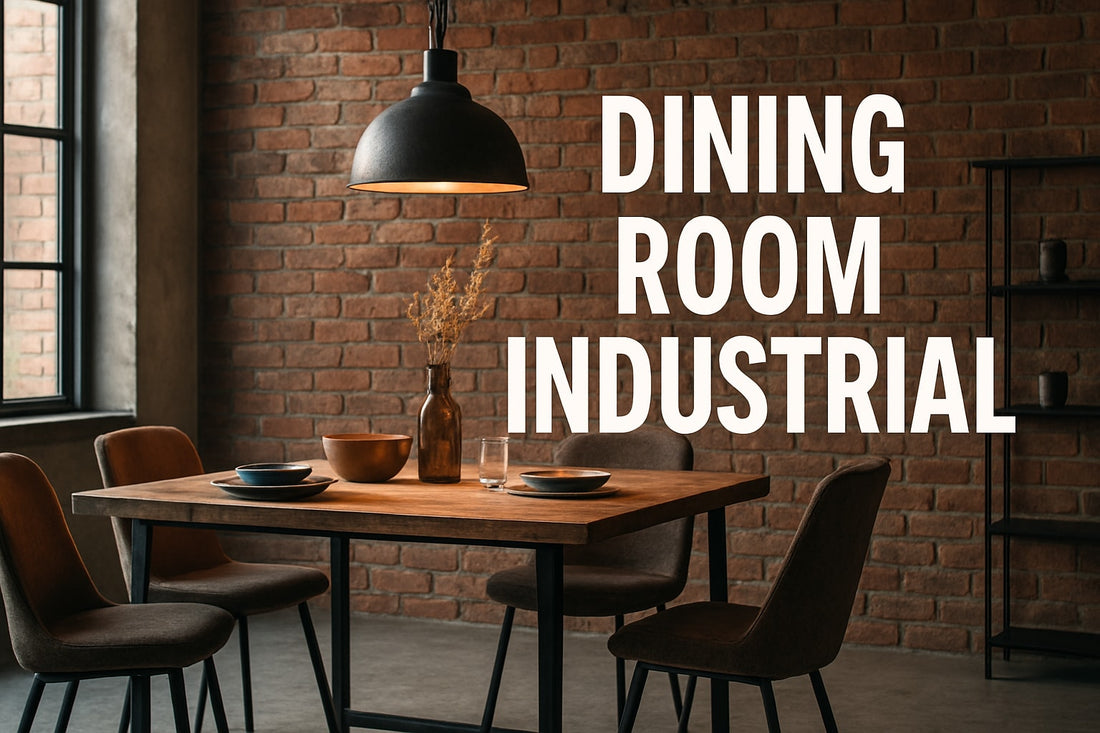
Dining Room Industrial Guide: Modern Ideas for 2025
Share
Industrial design continues to captivate homeowners and designers, with the dining room industrial look gaining momentum in 2025. The blend of raw textures, exposed elements, and modern finishes sets the stage for a space that is both stylish and practical.
This guide is crafted to help you master the dining room industrial trend, whether you are renovating, redecorating, or simply searching for inspiration. You will discover the latest design principles, trending materials, statement furniture, lighting tips, color palettes, and practical layout strategies.
Ready to transform your space? Dive in to explore fresh ideas and envision your own industrial-inspired dining room that stands out in 2025.
Core Principles of Industrial Dining Room Design
The dining room industrial style is rooted in a deep appreciation for authentic materials and utilitarian beauty. This design approach finds its origins in converted warehouses and lofts, where exposed brick, concrete, and metal became celebrated features rather than hidden flaws. Unlike traditional or rustic dining spaces, dining room industrial interiors emphasize rawness, visible structure, and a sense of openness. Hallmarks include exposed ductwork, steel beams, and unfinished surfaces, all contributing to an environment that feels honest and unpretentious. For example, an open-plan dining area featuring visible brick and metal piping instantly signals the industrial aesthetic.
Defining the Industrial Aesthetic
At its core, dining room industrial design draws from the adaptive reuse of old factories and urban lofts. This gives spaces a distinct character defined by visible construction elements and purposeful materials. Key features include:
- Exposed brick walls and concrete floors
- Steel beams and industrial hardware
- Open layouts with minimal internal walls
Unlike more ornate or rustic styles, dining room industrial spaces favor simplicity and function. The raw, unfinished look is intentional, creating a backdrop that feels both bold and welcoming. Examples like exposed ductwork or unpolished wood add to the room’s unique personality.
Key Elements of Modern Industrial Style
Today’s dining room industrial interiors embrace modern minimalism while honoring their gritty roots. Clean lines and uncluttered spaces are essential, making rooms feel airy and contemporary. Designers achieve visual interest by mixing materials such as concrete, blackened metal, and reclaimed wood. Comfort is introduced by balancing hard surfaces with soft textures, like leather chairs or plush rugs. Open-concept layouts are popular, allowing light and movement to flow freely. Architectural details—such as steel-framed windows or sliding barn doors—serve as striking focal points, blending industrial heritage with modern sensibility.
Functionality Meets Style
A dining room industrial space prioritizes both practicality and visual appeal. Furniture and finishes are chosen for durability, making them ideal for busy households. Multi-purpose pieces—like extendable tables or benches with hidden storage—maximize utility without sacrificing style. The industrial approach is inherently family-friendly, accommodating everything from casual meals to festive gatherings. Adaptable layouts allow homeowners to tailor the dining area for different needs, ensuring flexibility. For example, a robust dining table can serve as a workspace during the day and transition seamlessly for entertaining in the evening.
Evolving Trends for 2025
In 2025, dining room industrial trends are evolving to include sustainability and softer influences. Homeowners are increasingly selecting recycled metals and salvaged wood, reflecting a commitment to eco-friendly design. Industrial spaces now often blend with Scandinavian or Japandi styles, introducing lighter colors and more refined textures for a gentler look. Technology is also making its mark, with smart lighting and integrated charging stations enhancing convenience. According to recent reports, 68 percent of new dining room renovations incorporate industrial elements, underscoring the style’s growing popularity. For a deeper look at these shifts, explore Rustic-Industrial Design Trends in 2025, which highlights authenticity and sustainability as defining factors in today’s industrial dining rooms.
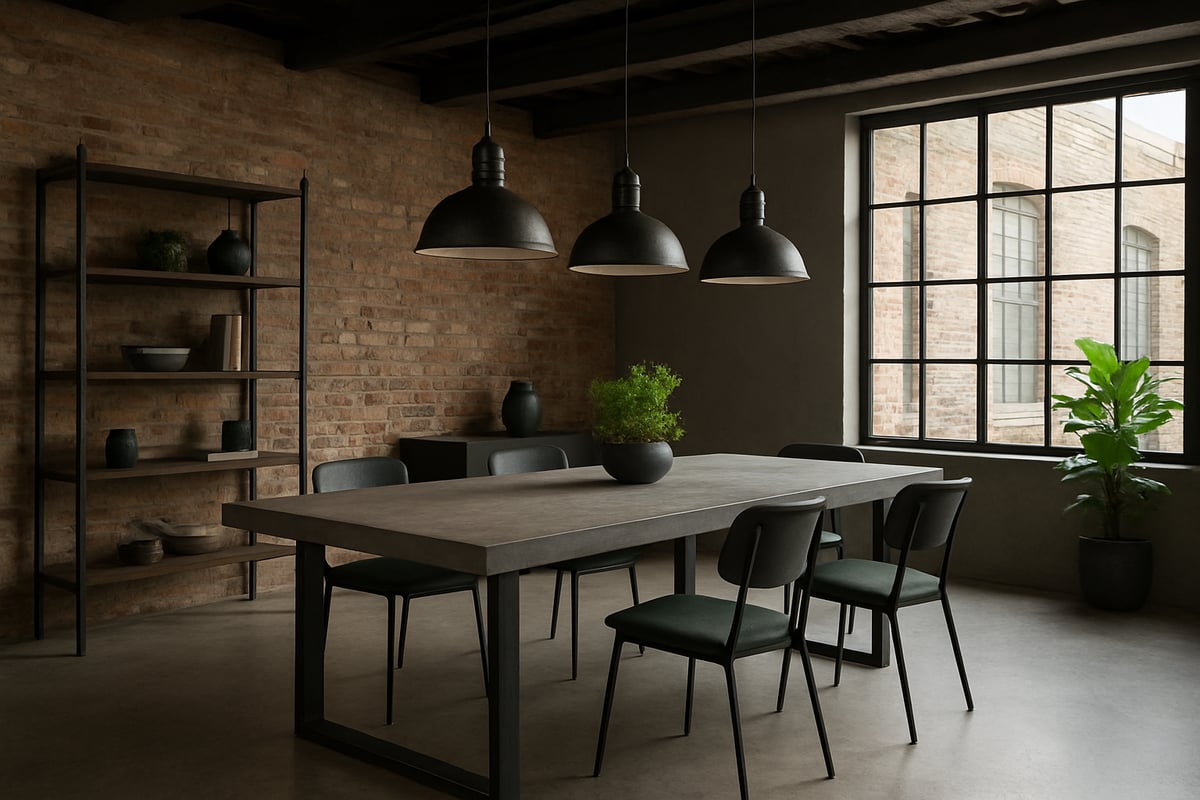
Trending Materials & Finishes for 2025
The materials and finishes you choose will define the essence of your dining room industrial space in 2025. Designers continue to push boundaries, blending raw textures with modern treatments for a look that is both timeless and forward-thinking.
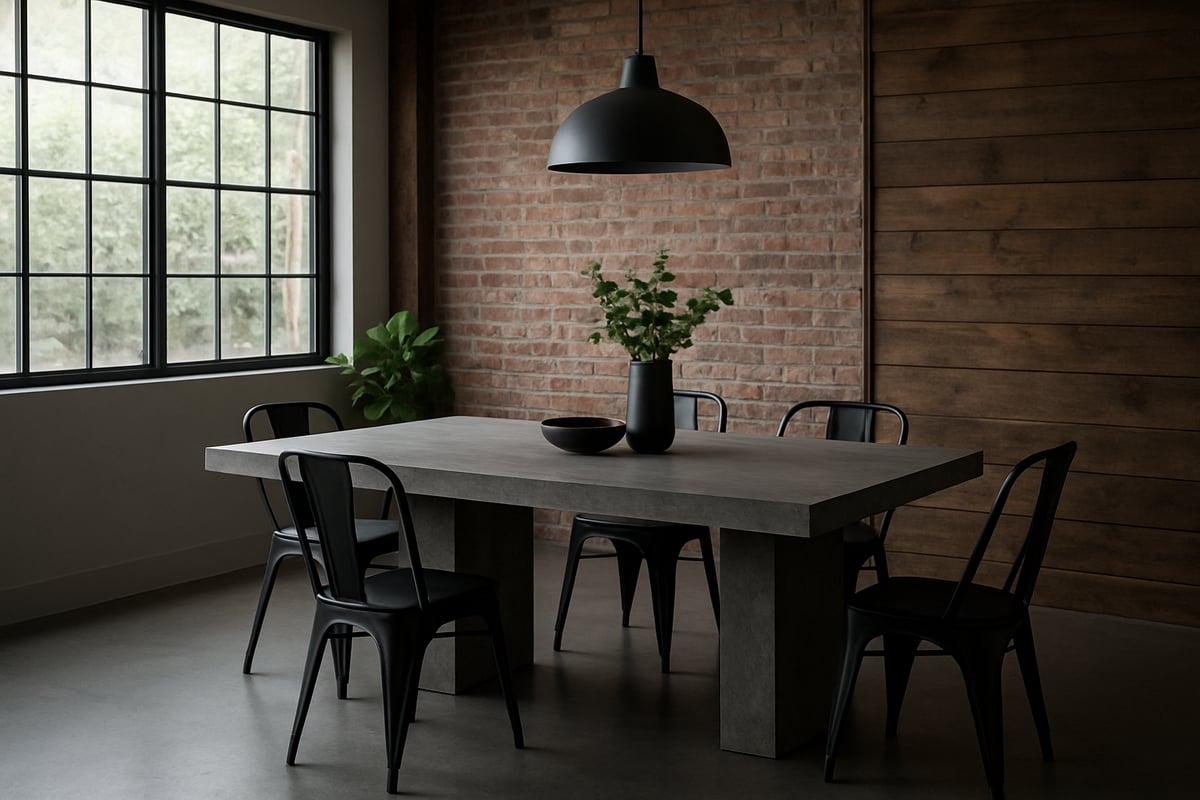
Concrete, Metal, and Wood: The Industrial Trinity
Concrete, metal, and wood are the foundation of every dining room industrial design. Concrete appears in tables, floors, and accent walls, lending a sense of permanence and urban edge. Metals like blackened steel, brushed brass, and matte iron create striking contrasts and offer structural integrity. Reclaimed and distressed woods warm up the space with their unique textures and history.
For instance, a concrete-topped table with steel spider legs anchors the room, while wooden beams and shelving add character. If you want to see how these elements come together, explore the Industrial Concrete Dining Tables collection for inspiration. These materials define the dining room industrial style for 2025, balancing strength with inviting warmth.
Innovative Surface Treatments
Surface treatments are evolving, making the dining room industrial look even more dynamic. Microcement and polished concrete produce seamless, easy-to-maintain surfaces that suit both floors and tabletops. Powder-coated metals introduce color and enhance durability, resisting scratches and stains for years.
Textured finishes are on the rise, with fluted, ribbed, or grooved wood and metal details adding tactile interest. Imagine a dining space with a fluted concrete table or ribbed metal chairs, offering both visual depth and a modern twist on classic materials. These innovative treatments keep the dining room industrial trend feeling fresh and contemporary.
Sustainable & Eco-Friendly Choices
Sustainability is at the forefront of dining room industrial design in 2025. Homeowners increasingly favor recycled metals and salvaged woods, reducing environmental impact while celebrating authentic character. Low-VOC finishes and natural sealants further ensure healthy indoor air quality.
Transparency in sourcing is also a top priority, with many opting for furniture certified for eco-friendly practices. According to recent data, 55% of buyers now prioritize sustainability when selecting furnishings for their dining room industrial projects. This shift means your choices can be both beautiful and responsible.
Color Palettes and Material Pairings
Color sets the tone for any dining room industrial space. Dominant hues include charcoals, soft greys, deep greens, and muted earth tones, which ground the room and highlight material textures. Accent colors such as rust, ochre, navy, and matte black add richness and visual intrigue.
Pairing raw materials with plush textiles is a key trend. For example, layer a velvet or leather cushion on a steel chair, or add a wool rug beneath a concrete table. Below is a sample palette for inspiration:
| Core Colors | Accent Colors |
|---|---|
| Charcoal | Rust |
| Deep Green | Navy |
| Soft Grey | Ochre |
This approach makes the dining room industrial style both inviting and sophisticated.
Statement Surfaces & Feature Walls
Feature walls and statement surfaces are essential for a memorable dining room industrial atmosphere. Exposed brick, concrete, or wood panel accent walls serve as bold focal points, while metal mesh partitions or sliding doors help define spaces without closing them off.
Large-scale art or graphic murals bring a modern edge, allowing you to personalize your dining room industrial environment. Leading interior design magazines frequently showcase spaces with dramatic feature walls, proving this trend is here to stay for 2025.
Must-Have Industrial Dining Room Furniture
Creating a dining room industrial space starts with the right furniture choices. Each piece should balance rugged durability with modern style, making your dining area both practical and visually striking. Carefully selected tables, seating, storage, and accessories define the character of the room and set the stage for memorable gatherings.
Dining Tables: The Centerpiece
A dining room industrial design always begins with a statement table. Large, robust tables in concrete, reclaimed wood, or a blend of materials are popular choices. Rectangular, round, and live-edge shapes offer versatility for different layouts.
Look for tables with metal bases and exposed hardware for an authentic touch. Details like steel spider legs or visible joinery add industrial flair. For inspiration, the Concrete Dining Table and Bench Set showcases how concrete surfaces and metal frames can anchor a dining room industrial space.
When selecting your table, consider both durability and visual weight. Concrete options are especially prized for their longevity and unique texture, making them a favorite among designers in 2025.
Seating Solutions: Chairs, Benches, and Mix-and-Match Styles
Seating in a dining room industrial setup is all about mixing comfort with character. Metal-framed dining chairs, sometimes upholstered in leather or linen, are a staple. Industrial-style benches provide communal seating and maximize space, especially in open-plan layouts.
Mixing vintage pieces with new designs creates an eclectic look that feels curated and personal. For added comfort, choose chairs with ergonomic support and cushions in muted tones.
Key tips:
- Alternate chair styles for visual interest.
- Use benches on one or both sides of the table.
- Pair metal with soft textiles for balance.
This approach gives your dining room industrial seating both functionality and a lived-in, welcoming feel.
Storage & Display: Sideboards, Cabinets, and Shelving
Effective storage is essential in any dining room industrial scheme. Open shelving crafted from metal or wood provides a place to display ceramics, glassware, or art. Sideboards with industrial hardware add storage and visual interest, while glass-front cabinets with steel frames keep items visible yet protected.
Multi-functional storage is trending for smaller spaces. Look for sideboards that double as serving stations or shelves with integrated wine racks.
Ideas for maximizing storage:
- Floating shelves for a light, airy effect.
- Tall cabinets for ample hidden storage.
- Metal mesh doors for an unexpected industrial detail.
Keep storage pieces in line with the overall aesthetic to reinforce the dining room industrial vibe.
Accessorizing with Industrial Flair
Accessories bring personality to your dining room industrial environment. Metal-framed mirrors, vintage clocks, and factory-inspired art add layers of interest. On the table, concrete or metal centerpieces, sculptural bowls, and industrial-style tableware reinforce the theme.
Introduce greenery with rugged planters in concrete or matte metal for a touch of softness. Mixing materials like glass and steel in your decor helps create dynamic contrasts.
Consider these accents:
- Decorative concrete bowls as table highlights
- Industrial pendant lighting for atmosphere
- Wall art or murals with bold graphics
Well-chosen accessories make your dining room industrial space feel curated and complete.
Concrete Artisan: Bespoke Concrete Furniture
For those seeking a truly unique dining room industrial centerpiece, Concrete Artisan offers handcrafted concrete dining tables and accessories. Their bespoke, made-to-order pieces allow for customization in size, finish, and style, ensuring a perfect fit for any vision.
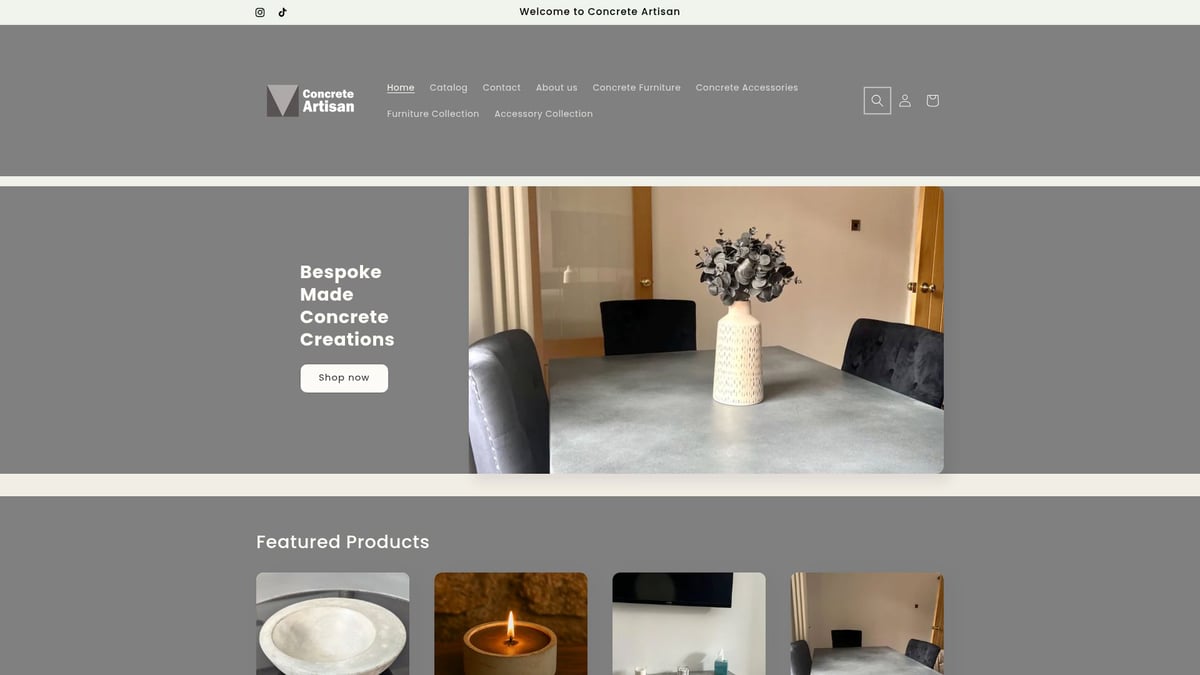
Concrete is not only robust but also beautifully modern, offering both durability and artistry. Homeowners can select from a range of finishes, from smooth polished surfaces to more textured, rustic looks.
Choosing bespoke furniture means your dining room industrial design stands out, reflecting your personal style while withstanding the demands of daily use. Concrete Artisan’s creations are ideal for anyone wanting a statement piece that defines their space.
Lighting & Ambience in the Industrial Dining Room
Lighting is a defining element in any dining room industrial space, shaping both the aesthetic and the mood. The right fixtures and ambience can transform raw materials into a welcoming environment. In 2025, lighting continues to push boundaries, merging industrial edge with modern innovation.
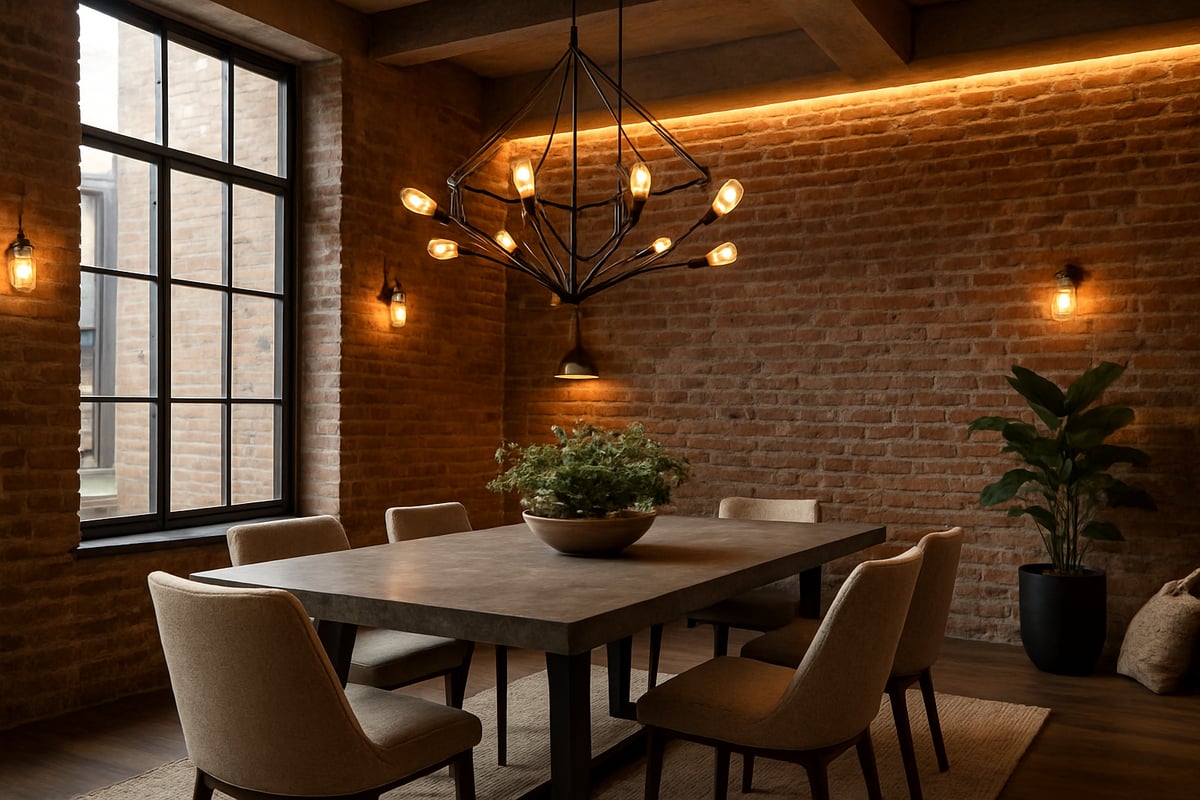
Statement Industrial Lighting Fixtures
Choosing statement lighting is essential for the dining room industrial look. Popular options include pendant lights with metal shades, oversized chandeliers, and geometric suspension fixtures. Exposed bulbs, often in Edison or filament styles, reinforce the industrial vibe while providing ample illumination.
Designers are experimenting with bold forms like linear metal lights or cluster pendants positioned over the dining table. These fixtures become functional art, drawing the eye and setting the tone for the space. Mixing blackened steel, matte brass, or even concrete shades adds texture and depth to the overall lighting scheme.
Integrating Smart Lighting & Technology
Modern dining room industrial design embraces technology for both convenience and style. App-controlled dimmers and color temperature adjustments allow users to tailor lighting for any occasion. Hidden LED strips provide accent lighting under shelves or along architectural features, enhancing the layered effect.
Some fixtures now include integrated charging ports or smart controls, blending technology seamlessly into the industrial aesthetic. According to Dining Room Lighting Innovations for 2025, nearly 40 percent of new installations feature smart lighting components. These advancements offer homeowners flexibility, energy savings, and a futuristic edge.
Creating Warmth in Raw Spaces
While the dining room industrial style celebrates raw materials, creating warmth is key to making the space inviting. Warm-toned bulbs—such as soft white or amber—help soften the look of metal and concrete. Dimmable fixtures allow for mood adjustments, perfect for both casual meals and formal gatherings.
Layering is essential: combine pendant lights with candles, floor lamps, or wall sconces for a multidimensional glow. Pairing metal fixtures with glass diffusers or fabric shades can further temper the industrial coolness, resulting in a balanced, comfortable atmosphere.
Lighting Placement & Layout Tips
Effective lighting placement enhances both function and style in a dining room industrial setup. Centering a fixture above the dining table creates symmetry and focus. Use track lighting to spotlight artwork or feature walls, and highlight architectural details like exposed beams or brickwork.
In open-plan spaces, lighting can define the dining area, especially when paired with area rugs or partitions. For smaller rooms, choose fixtures that maximize light without overwhelming the space. Thoughtful layout ensures every meal is enjoyed in the perfect ambience.
Color Schemes & Decor Accents for 2025
Selecting the right color palette and decor accents is essential for any dining room industrial design. In 2025, new trends are shaping how homeowners bring character and warmth to these spaces. A thoughtful mix of hues, textures, and accessories ensures your dining room industrial concept feels both authentic and inviting.
Trending Color Palettes
Color trends for dining room industrial spaces in 2025 emphasize a sophisticated balance of core neutrals and bold accents. Charcoal, slate, taupe, and off-white create a grounded backdrop, while forest green, terracotta, and navy blue provide visual punch. Designers often use color zoning, such as a deep-toned accent wall or a painted ceiling, to define the dining area in open layouts.
Layering these tones with metallics like matte black or brushed brass elevates the dining room industrial mood. For more inspiration on this year's palettes and other must-know ideas, explore the Top 6 Dining Room Trends for 2025. These combinations offer a fresh yet timeless canvas for your dining room industrial project.
Textiles & Soft Furnishings
Textiles bring essential comfort to the dining room industrial aesthetic. In 2025, designers favor layering leather, linen, and velvet to contrast with the rawness of concrete, brick, or metal. Rugs with geometric or abstract patterns anchor the dining zone, while plush cushions and throws soften the look of metal-framed chairs or wood benches.
Layered rugs under an industrial table not only add comfort but also define the space visually. Mixing tactile materials ensures the dining room industrial ambiance remains warm and welcoming, especially in homes with open layouts or hard surfaces. This approach creates an inviting atmosphere for everyday meals and entertaining alike.
Art, Wall Decor, and Greenery
Art and wall decor are essential for injecting personality into any dining room industrial scheme. Large-scale abstract paintings or black-and-white photography make a striking statement against brick or concrete walls. Metal wall sculptures, oversized clocks, or vintage signage reinforce the industrial theme while adding visual interest.
Incorporating greenery in concrete or metal planters introduces life and color, balancing the space's cool tones. Some dining rooms feature living plant walls or clusters of sculptural plants for a modern, organic touch. These elements help transform the dining room industrial environment into a vibrant, lived-in retreat.
Tabletop & Accessory Trends
Tabletop styling in 2025 leans into the dining room industrial look with concrete, ceramic, and metal tableware. Minimalist centerpieces, like sculptural bowls or clusters of candles, keep surfaces uncluttered yet visually engaging. Dried botanicals and vintage finds mix seamlessly with modern accessories for a curated feel.
Concrete trays, platters, or handmade pieces add an artisan touch. For more inspiration on how to incorporate concrete elements into your dining room industrial setup, visit Concrete Furniture Design Ideas. Notably, demand for artisan-made decor has risen by 30 percent this year, confirming the appeal of unique, handcrafted accents in dining room industrial interiors.
Layouts & Space Planning for Industrial Dining Rooms
Designing a dining room industrial layout requires thoughtful planning to balance aesthetics and functionality. The right layout will highlight industrial features while ensuring comfort and flow. Whether your space is open or defined, adopting strategic arrangements can help you create a visually striking and highly usable dining area.
Open-Concept vs. Defined Dining Spaces
Open-concept layouts are a hallmark of the dining room industrial style. These spaces often merge the dining area with the kitchen or living room, creating a seamless flow. To define your dining zone within an open area, consider using a large area rug, distinct lighting above the table, or a metal and glass partition.
Loft apartments often showcase this approach, while traditional homes may opt for partial walls or sliding doors to distinguish zones. For small spaces, opt for space-saving furniture and clever visual cues to keep the room feeling open yet distinct.
According to Dining Room Design Trends 2025, more homeowners are embracing flexible layouts and integrated dining zones to maximize usability and style. This approach ensures your dining room industrial space feels both current and highly functional.
Furniture Arrangement & Flow
Arranging furniture in a dining room industrial space is all about optimizing movement and interaction. Place your table in the center of the room for a balanced look, ensuring enough clearance around chairs for easy access. Benches against walls can help save space and add communal seating.
Multi-use layouts are also gaining popularity, allowing the dining area to double as a workspace or entertaining zone. Modular furniture, such as extendable tables or stackable chairs, offers flexibility for different occasions.
When planning your arrangement, keep pathways clear and prioritize comfortable circulation. This not only enhances the industrial aesthetic but also makes daily use more enjoyable in your dining room industrial setting.
Maximizing Light & Views
Natural light is a prized feature in any dining room industrial design. Large windows, glass doors, and reflective surfaces help amplify brightness and showcase raw textures. Placing mirrors strategically across from windows can further enhance natural light and make the space feel larger.
For privacy without sacrificing light, opt for sheer curtains or minimalist blinds. Industrial spaces often benefit from the interplay between sunlight and materials like concrete, metal, and exposed brick.
According to recent surveys, 78% of homeowners consider maximizing natural light a top priority. Embracing these principles ensures your dining room industrial space feels open, airy, and welcoming.
Practical Considerations & Maintenance
Choosing durable, easy-to-clean materials is essential for a family-friendly dining room industrial space. Concrete, metal, and treated wood are robust choices that can withstand daily wear. Regularly sealing concrete surfaces and wiping metal finishes helps preserve their look.
Incorporate rugs, textiles, or wall panels to absorb sound, especially in open layouts. This improves both comfort and acoustics. If you have pets or children, select finishes that resist scratches and stains.
For those interested in unique surfaces, concrete furniture is both stylish and practical. Learn more about care and maintenance in the Beauty of Concrete Furniture guide, which details how to keep concrete dining pieces looking their best in a dining room industrial setting.
